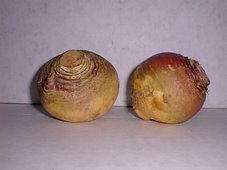
Welcome to the new and improved Rutabagan, sponsored by the Advanced Rutabaga Studies Institute in Forest Grove,
To get things started, here's our Letter of the Day:
C.J.: "My mother-in-law refers to rutabagas as "rutabagie" (or "rutabaggie," "rutabagy," or "rutabaggy"; I've never asked her to spell it). At first, this just made me bite my tongue and chuckle quietly inside at family gatherings. But after some research, making rutabaga plural by adding a "y" or "ie" ending seems to have come from northern
Thanks for your interesting query, C.J. The ultimate source on such etymological questions is the indefatigable Finnish rutascholar Hannu Ahok, who claims that the rutabaga resulted from the hybridization of turnips and cabbages by Finnish farmers. He states that Finnish immigrants "probably brought rutabagas to
Finnish immigrants to
Source: On the Evolution, Spread and Names of Rutabaga, by Hannu Ahokas, Interdisciplnary Biology, Agriculture, Linguistics and Antiquities 1:1-32 (2004).
[Please note that many ARSI rutabotanists are now convinced that the turnip and cabbage are hybridized variations of the rutabaga, rather than the reverse.]





4 comments:
Complètement modeste enfin Nous devons avoir beaucoup de peuples des cultures impaires dans notre manoir pendant des vacances en mois de rutabaga. AM dans souhaiter fini de douleur comprendre le choix du vin pour exhiber mieux les tendances du 'baga. Énormément vôtre, Karine
Es ist eine vorhin wenig bekannte Tatsache, daß das getrocknete Rübepuder, leicht abgewischt unter den Armen und im Nabel, diese Mikrobe-geplagten Bereiche dezimiert und sie geruchsfrei macht.
Chère Karine,
Comme vin qui exhibite mieux "les tendances du 'bega," je peux vivement vous recommander le 1979 Château de Corton-André (Côte de Beaune), qui vous offre une dégustation souple, rond et velouté.
J'ose aussi vous recommander un vodka polonais de rutabaga, si vous pouvez en trouver (même en Pologne).
Bon appétit, et meilleurs voeux pour un joyeux Noël et une bonne et heureuse année,
Obie MacAroon III
Lieber Freund,
Danke zu dieser faszinierenden Information, die mein Nabel und Unter Armen (und meine Frau!) schätzen.
Obie MacAroon III
Post a Comment